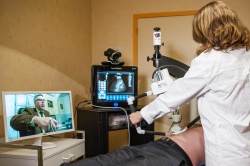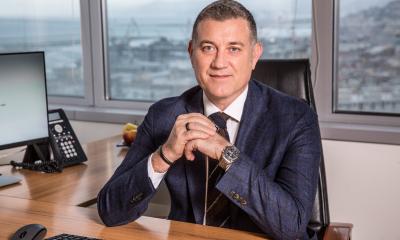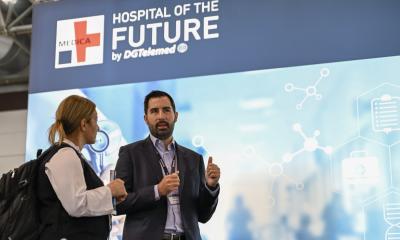Robotic
The long arm of ultrasound
Now there are two ways to remotely examine a patient with ultrasound without leaving your office. With the novel, Melody robotic ultrasound method, the expert consultant is connected to the remote patient site through a video conference link and, using a mouse-like device, the radiologist can perform the exam by manipulating an ultrasound probe positioned on the patient’s body.
Report: John Brosky


The other way this is done is a conventional method in which a trained operator at the remote site records the exam and sends the file to the expert over the internet. Because an ultrasound exam is only as good as the operator performing the exam, the Melody robot method allows the experts to directly apply their experience, as well as their professional responsibility for the diagnoses.
This critical difference between the two approaches to teleradiology won a frontline presentation for the robot’s creator, AdEchoTech at this year’s French Radiology Congress in Paris. Robots are usually viewed by the French as job-stealing contraptions and are fiercely resisted. Yet here radiologists were lining up to hear how this robotic system can extend their practices by performing remote ultrasound exams in under-served rural regions, or else in prisons, on oil platforms, or aboard cruise ships in the Mediterranean carrying 5,000 passengers.
They also learned that the robot does not replace the ultrasound technician at the remote exam site. Au contraire, French radiologists were shown how the role of the technician is elevated and could well be expanded in remote medical centres thanks to the robot.
Michel Claudon MD, a radiologist from the University Hospital in Nancy, France, presented colleagues with a review of published papers validating the remote examination approach in ultrasound.
In an extreme example, Claudon cited a demonstration documented in a 2011 article in the Journal of Emergencies, Trauma, and Shock where a just-in-time, pleural and lung ultrasound exam was displayed in real-time for an expert evaluation on a smartphone, using a portable ultrasound probe interfaced with a laptop computer, with video-streaming over Skype.
The key distinguishing features of the approach enabled by Melody, he said, is that the examination is synchronous, performed in real-time, as opposed to asynchronous with the record and upload method.
The Melody system is based on a robotic arm controlled by the ultrasound technician. Using the Melody Patient system, the technician at the patient’s side at a remote centre places a frame with the ultrasound transducer over the area of interest and applies gel to the targeted zone. The robotic control arm can accept any ultrasound probe and plug into any ultrasound platform for the exam, according to Nicolas Lefebvre, general manager for AdEchoTech.
Connected by high-speed land line, or satellite transmission, the Melody Expert system at a remote medical centre controls the movement of the probe at the patient site, and it is ‘marvellously sensitive and responsive,’ according to Claudon. Besides moving the probe side to side, the expert can also press the probe down for better signal penetration. The remote expert, who is simultaneously connected by video conferencing with the operator at the secondary centre, views the ultrasound exam in real-time.
Newly developed touch screen software, which can be loaded to any standard computer, according to Lefebvre, allows the ultrasound expert to adjust probe depth, the gain, switch on the Doppler function and otherwise operate the ultrasound platform at the patient’s side. One megabyte per second for both uploading and downloading is sufficient capacity for transmission of the exam and video conferencing.
By the end of the presentation session in Paris, no one was asking if the robot could play a role, but how it could be applied. In addition, in a positive sign for the company, the discussion broke up with radiologists kicking around their favourite topic of reimbursement.
17.11.2015











